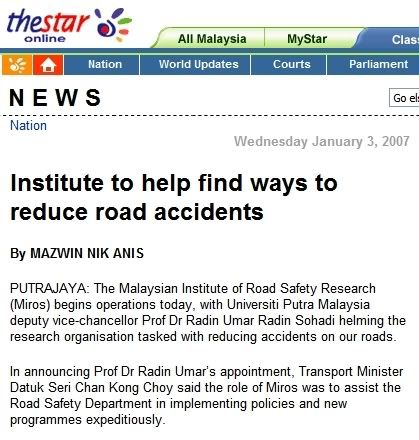Crash-Test Dummies
Technorati tags: Malaysia, Road Safety, Miros, Malaysian Institute of Road Safety Research, Research, Car Crash, Crash Test Dummies
If you've never heard of Miros, you're probably not alone. Walski just found out about it yesterday, too. Reason? They just started operations.
 Miros, introduced to the world by a real-life Crash Test Dummy...
Miros, introduced to the world by a real-life Crash Test Dummy...
Miros, incidentally, is the stylo-acronym for the Malaysian Institute of Road Safety Research, which was officially launched yesterday, and will be headed by Universiti Putra Malaysia (UPM) Vice-Chancellor Prof. Dr Radin Umar Radin Sohadi.
 Having investigated a little about Dr. Radin (with whatever little bandwidth not hogged by the corporation VPNs), Walski found out that the guy is indeed an authority on road engineering, and accident dynamics (particularly those involving motorbike riders), and has several publications and textbooks to his name. And not too bad looking a dude, either.
Having investigated a little about Dr. Radin (with whatever little bandwidth not hogged by the corporation VPNs), Walski found out that the guy is indeed an authority on road engineering, and accident dynamics (particularly those involving motorbike riders), and has several publications and textbooks to his name. And not too bad looking a dude, either.
So, in terms of qualifications, Walski has no complaints whatsoever.
But what is a little perplexing, though, is the role that Miros is to play in "road safety research", after Walski did some analysis on the news article. The following are excerpts from The Star article mentioned earlier on, with emphasis (by myAsylum) on the portions of the article which highlight Miros' role.
In announcing Prof Dr Radin Umar’s appointment, Transport Minister Datuk Seri Chan Kong Choy said the role of Miros was to assist the Road Safety Department in implementing policies and new programmes expeditiously.
It almost looks like someone forgot to look up the dictionary to find out the meaning of the word "research". If that's the intended role, what you need is better efficiency, not a research institute.
(more dummies crash-tested in the full post)
But wait... there's more!
Chan said various road safety initiatives would be carried out this year, including road safety education in schools from April, electronic enforcement effective June, traffic wardens in schools, and the second phase of the programme to encourage the use of helmets in rural areas.
“We will also be conducting competency grading for driving schools, investigations into fatal accidents, and, treating or repairing areas where accidents occur,” he said in a statement yesterday.
“All these initiatives must be evaluated and monitored for its effectiveness, impact and cost benefits. Research and monitoring of the programmes will be by Miros.”
And don't you dare touch those navigation keys, 'cause here's the clincher.
Miros, whose initial aim is to reduce road deaths by 50% in four years, is financed by the Government through a launching grant of RM50mil, with an operational cost of RM20mil yearly.
Sorry for being cynical, but isn't it a sheer waste of talent and resources (public money, at that) to supervise implementation of initiatives, conduct competency tests of driving schools (the job of the Road Transport Department, which licenses these establishments), and treating/repairing roads (definitely the job of someone else)? And reduce road deaths by any percentage? Dream on...
Walski accepts the investigation into fatal accidents bit - but why just the fatal ones? Does someone have to die before proper engineering-based investigations are done? Apparently, the sad answer to that question is yes.
In any case, to kick-start Miros into doing some real research, here are a few areas which Walski suggests Miros should really look into, rather than being glorified, over-funded bureaucrats (which we already have an over-abundance of):
- Investigate the reason why the white lines on the road totally disappear when it rains. Inferior paint? Or inferior painting? And why the time lag between resurfacing and redrawing lines (which poses a hazard)?
- Delve into the complex reasons why the majority of Malaysian drivers are too stupid to use their vehicle signal lights.
- Find out the science behind why potholes keep reappearing time and time again, in the same spots, after countless rounds of filling them up. It's almost as if they were a distinct species of live-forms with intelligence.
- Discover why is it so difficult to construct manhole covers at the exact same level as the road they are placed on. The Earth being round is not a valid excuse.
- Investigate and rectify the alignment and placement of streetlights, currently aligned just off-enough to leave a shadowy area where the edges of light dispersion coverage intersect.
- Develop a national standard for speed bumps
- Develop (or adopt from someone else) a proper standard for traffic signs, color codes and their placement.
- Ditto for traffic lines - Walski likes the British system (with proper merge indicators) - why the fuck can't we have a proper standard here?
- Find out, once and for all, the moron that decided the NPE (West-bound, towards Sunway), a 6-lane highway, needs a 60 km/h speed limit. Once found, hang the fucker on the next eve of an Eid.
- Ditto for the MRR2: 6-lane elevated stretches and fly-overs, 60 km/h speed limit (which no one in their right mind observes anyway).
- Develop a proper Malaysian standard for highway lane width, gradient and curvature - and make the toll highway operators fix their respective highways, at their own cost. The Karak-Kuantan Highway could be used as a model (apart from the standard used to ensure the highway's bumpiness)
- Provide an answer to the age-old mystery: Is it really okay to make a left turn on red, when there's no oncoming traffic?
There are, of course, countless other areas that Miros could look into, but let's just start with these. Answer these useful questions (and not the inane stupidity that Chan Kong Choy announced), and just maybe Miros could actually help in reducing road fatalities.
Otherwise, Malaysian motorists will forever remain the live crash-test dummies that they are, just waiting for the wrong real-life crash experiment to happen, when they least expect it. Sometimes involving an unexpected pothole.
 Walski's dummy explanatory note: Just in case you were wondering, this is what a real crash-test dummy looks like. Not to be confused with the rock group Crash Test Dummies, which looks nothing like Vince here.
Walski's dummy explanatory note: Just in case you were wondering, this is what a real crash-test dummy looks like. Not to be confused with the rock group Crash Test Dummies, which looks nothing like Vince here.
Crash test dummies are used by car manufacturers and 3rd party road/vehicle safety research institutes for destructive testing of vehicles, usually to study the impact of various accidents on vehicular passengers. These special-purpose mannequins are sometimes fitted with sensors to determine types and severity of injury, and the impact dynamics of a simulated vehicle crash.
Results of such testing usually get used to design safer vehicles, or to improve the safety of existing vehicles. One wonders if our own Malaysia car manufacturers bother to carry out such test.
One of the eventual facilities that Miros is to have (according to the news article) is a test facility, which presumably will have crash test circuits. And if that's the case, we would definitely find crash test dummies.
Walski is in no way implying any similarity whatsoever between a crash test dummy and Prof. Dr. Radin Umar. Honest. Chan Kong Choy, on the other hand, is a different story...
















